Defamation laws present significant hurdles for advocacy journalism, often leading to self-censorship and hindering the reporting of critical issues. Understanding these laws and implementing effective fact-checking measures are essential for journalists to navigate potential legal repercussions while maintaining their commitment to informing the public.
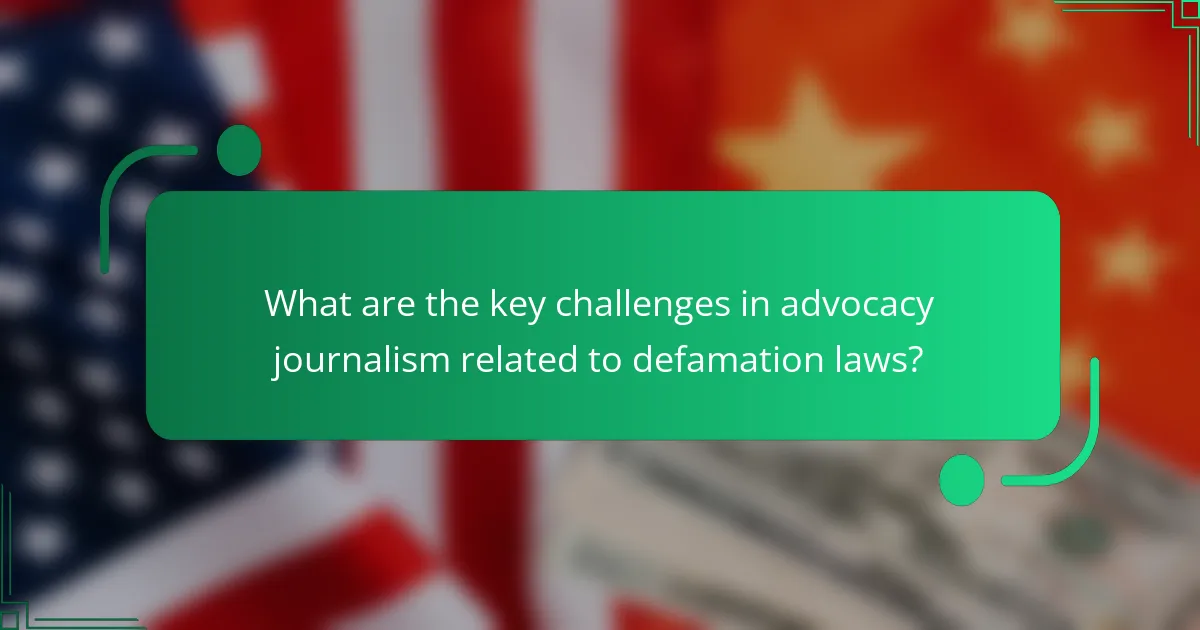
What are the key challenges in advocacy journalism related to defamation laws?
Advocacy journalism faces significant challenges due to defamation laws, which can deter journalists from reporting on sensitive issues. The risk of legal repercussions can lead to self-censorship, impacting the ability to inform the public effectively.
Legal risks of reporting
Journalists engaged in advocacy often navigate a complex landscape of defamation laws that vary by jurisdiction. In many countries, publishing statements that harm an individual’s reputation can lead to lawsuits, resulting in financial penalties or damages. Understanding the local laws is crucial to mitigate these risks.
For instance, in the United States, the standard for defamation is higher for public figures, requiring proof of actual malice. In contrast, other countries may have stricter liability standards, making it easier for individuals to pursue claims against journalists.
Impact on public interest
Defamation laws can significantly impact the public interest by limiting the dissemination of crucial information. When journalists fear legal action, they may avoid covering important stories that hold power to account, ultimately hindering transparency and accountability. This self-censorship can create a less informed public.
Moreover, when advocacy journalism is stifled, marginalized voices may remain unheard, further perpetuating social injustices. Balancing the need for accountability with the protection of individual reputations is essential for a healthy democracy.
Balancing truth and opinion
In advocacy journalism, distinguishing between fact and opinion is vital to avoid defamation claims. Journalists must ensure that their reporting is grounded in verifiable facts while clearly labeling opinions or interpretations. This practice helps protect against legal challenges while still allowing for passionate advocacy.
Additionally, using phrases like “according to” or “it is believed that” can help frame opinions without presenting them as facts, reducing the risk of defamation. Journalists should also consider including disclaimers when expressing personal views to further clarify the distinction.
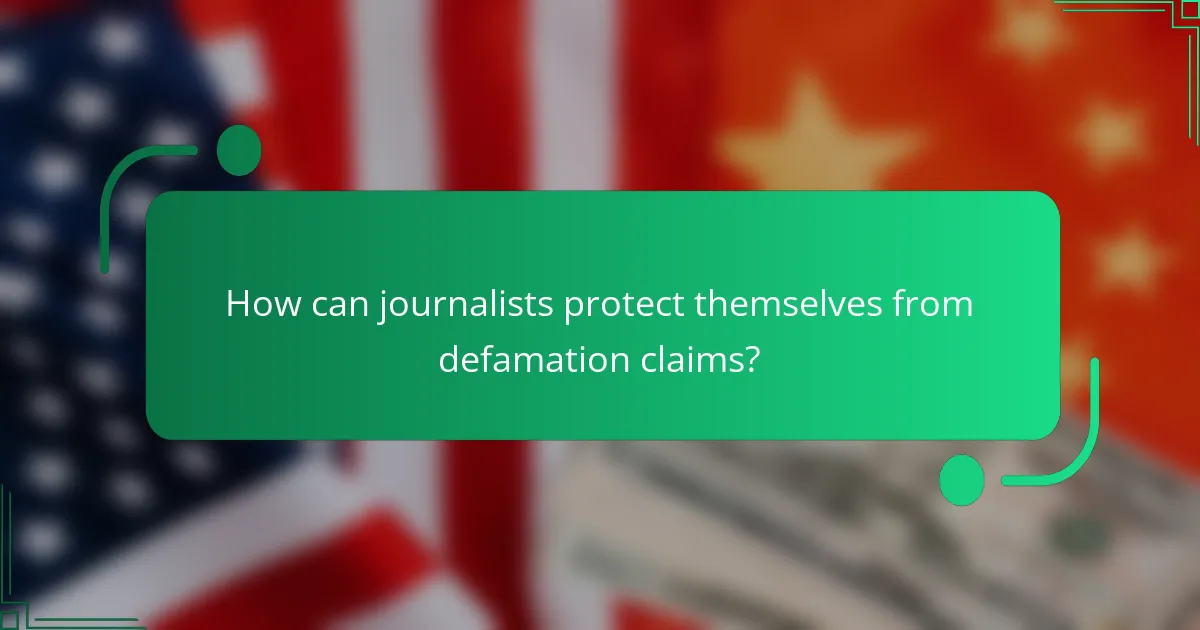
How can journalists protect themselves from defamation claims?
Journalists can protect themselves from defamation claims by adhering to legal guidelines, implementing robust fact-checking measures, and understanding the principles of fair use. These strategies help mitigate risks associated with publishing potentially harmful statements about individuals or organizations.
Utilizing legal counsel
Engaging legal counsel is crucial for journalists to navigate the complexities of defamation laws. A qualified attorney can provide guidance on the legal standards in their jurisdiction, helping to identify potentially defamatory content before publication.
Regular consultations with legal experts can also assist in developing editorial policies that minimize legal exposure. Journalists should consider retaining a lawyer who specializes in media law to ensure they are well-informed about their rights and responsibilities.
Implementing fact-checking protocols
Establishing rigorous fact-checking protocols is essential for reducing the risk of defamation. Journalists should verify the accuracy of their sources and claims before publication, using multiple reliable sources whenever possible.
Creating a checklist for fact-checking can streamline the process. This checklist might include confirming the identity of sources, cross-referencing information, and ensuring that statements are not misleading or taken out of context.
Understanding fair use
Fair use is a legal doctrine that allows limited use of copyrighted material without permission, which can be beneficial for journalists. Understanding the nuances of fair use can help journalists avoid infringing on others’ rights while still reporting on important issues.
Journalists should familiarize themselves with the four factors that determine fair use: the purpose of use, the nature of the copyrighted work, the amount used, and the effect on the market value. This knowledge can guide them in making informed decisions about how to use third-party content responsibly.
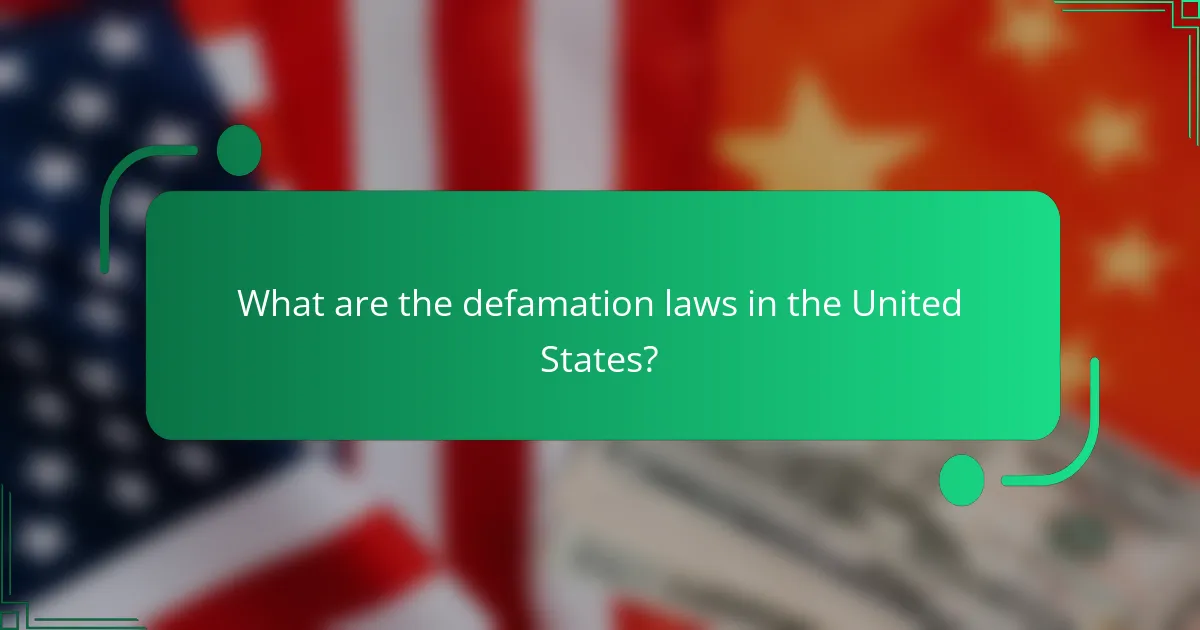
What are the defamation laws in the United States?
Defamation laws in the United States protect individuals and entities from false statements that harm their reputation. These laws vary by state but generally require the plaintiff to prove that the statement was false, damaging, and made with a certain level of fault.
Overview of state laws
Each state has its own defamation laws, which can lead to significant variations in how cases are handled. Most states recognize two types of defamation: libel (written statements) and slander (spoken statements). Plaintiffs typically need to demonstrate that the statement was made with negligence or actual malice, particularly if the plaintiff is a public figure.
For example, states like New York and California have specific statutes that outline the requirements for defamation claims, including the necessity of proving damages in certain cases. Understanding the nuances of state laws is crucial for journalists and advocates to navigate potential legal challenges effectively.
Key federal regulations
While defamation is primarily governed by state law, federal regulations can influence how cases are adjudicated. The First Amendment provides broad protections for free speech, which can complicate defamation claims, especially involving public figures or matters of public concern.
Additionally, the Communications Decency Act (CDA) offers some immunity to online platforms for content posted by third parties, which can impact how defamation cases are pursued against journalists or media organizations. Understanding these federal protections is essential for those engaged in advocacy journalism.
Recent case law examples
Recent court cases have highlighted the evolving landscape of defamation law in the U.S. For instance, the Supreme Court’s ruling in *New York Times Co. v. Sullivan* established the “actual malice” standard, which remains a cornerstone of defamation law for public figures. This case set a high bar for proving defamation, emphasizing the need for clear evidence of intent to harm.
Another notable case is *Dominion Voting Systems v. Fox News*, where the court examined the balance between free speech and the responsibility to avoid spreading false information. Such cases illustrate the ongoing tensions between journalistic freedom and the legal repercussions of defamation, making it critical for journalists to stay informed about current legal precedents.
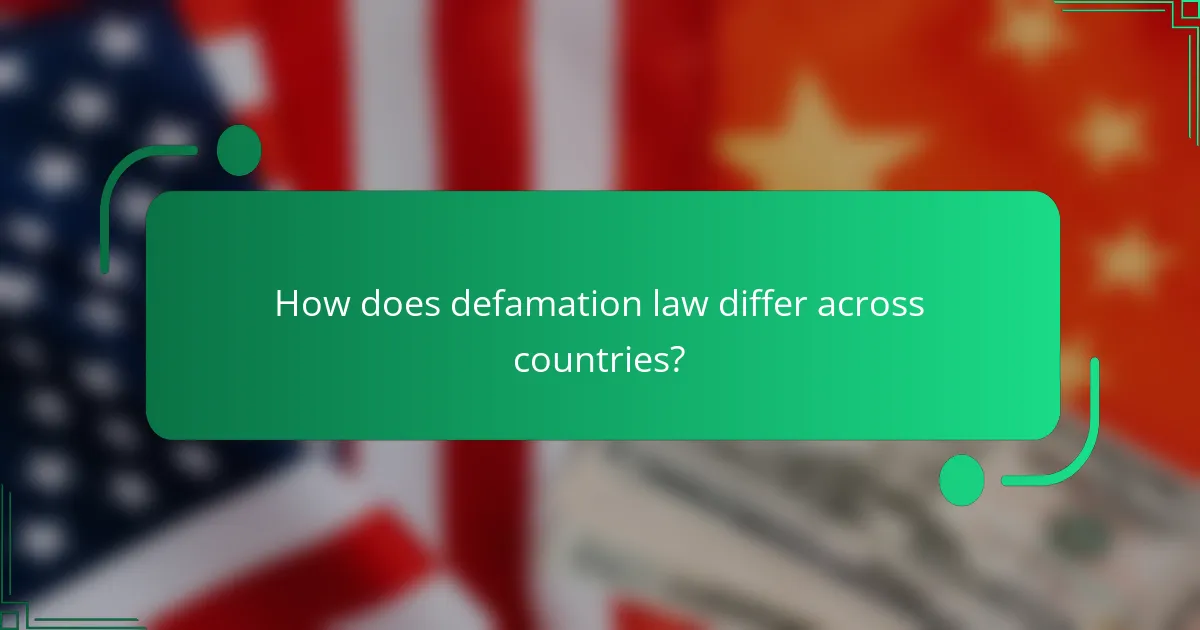
How does defamation law differ across countries?
Defamation law varies significantly across countries, influenced by cultural norms, legal traditions, and the balance between free speech and protection of reputation. Understanding these differences is crucial for journalists to navigate potential legal challenges in advocacy journalism.
Comparative analysis of UK and US laws
The UK and US have distinct approaches to defamation. In the UK, the burden of proof lies with the defendant, who must demonstrate that their statement is true. This makes it easier for claimants to win cases, as they do not have to prove that the statement caused harm.
In contrast, US defamation law, particularly under the First Amendment, requires public figures to prove “actual malice” to win a case. This means they must show that the statement was made with knowledge of its falsity or reckless disregard for the truth, making it more challenging for them to succeed in defamation claims.
International defamation standards
Internationally, defamation laws are influenced by various treaties and human rights standards. The International Covenant on Civil and Political Rights emphasizes the importance of freedom of expression, which can conflict with defamation laws that protect reputation.
Many countries have adopted laws that reflect a balance between these interests, but the specifics can vary widely. For example, some nations impose strict penalties for defamation, while others have more lenient approaches that prioritize free speech. Journalists should be aware of these standards when reporting internationally to avoid legal repercussions.

What role does public opinion play in defamation cases?
Public opinion can significantly influence defamation cases, as juries often consider societal views when making decisions. A strong public sentiment can sway perceptions of truth and harm, impacting the outcome of legal proceedings.
Influence on jury decisions
Juries may be affected by prevailing public attitudes, which can shape their understanding of what constitutes defamation. If a case garners substantial media attention, jurors might be influenced by the narratives they encounter outside the courtroom, leading to biases that could affect their judgment.
For instance, if a public figure is widely perceived as a victim of unfair treatment, jurors may lean towards favoring that individual in a defamation case, regardless of the actual evidence presented. This underscores the importance of managing public perception during high-profile trials.
Impact of social media
Social media plays a crucial role in shaping public opinion, often amplifying narratives that can influence defamation cases. Platforms like Twitter and Facebook can quickly disseminate information, creating a public discourse that jurors may be exposed to before or during a trial.
Moreover, the viral nature of social media can lead to the rapid spread of misinformation, complicating the legal landscape. Advocates should be aware of how online sentiment can affect jury perceptions and consider strategies to counteract negative narratives that may arise in the digital sphere.

What are the implications of defamation for digital journalism?
Defamation in digital journalism can lead to significant legal consequences, including lawsuits and financial penalties. Journalists must navigate the fine line between reporting facts and potentially harming an individual’s reputation, which can result in costly litigation and damage to credibility.
Challenges of online platforms
Online platforms present unique challenges for journalists regarding defamation. The rapid dissemination of information can lead to the spread of false claims before they are verified, increasing the risk of legal repercussions. Additionally, the anonymity of many online users complicates accountability, making it difficult to address defamatory statements effectively.
Journalists must be vigilant in verifying sources and claims, as the speed of digital news can lead to hasty conclusions. Implementing fact-checking protocols and maintaining a clear editorial policy can help mitigate these risks.
Legal protections for digital content
Legal protections for digital content vary by jurisdiction but generally include defenses such as truth, opinion, and fair reporting. In the United States, for example, the First Amendment provides strong protections for journalists, allowing for robust reporting on matters of public interest.
However, these protections are not absolute. Journalists should be aware of local laws and regulations, as some countries have stricter defamation laws that can impose significant liabilities. Understanding the legal landscape is crucial for responsible reporting and minimizing the risk of defamation claims.
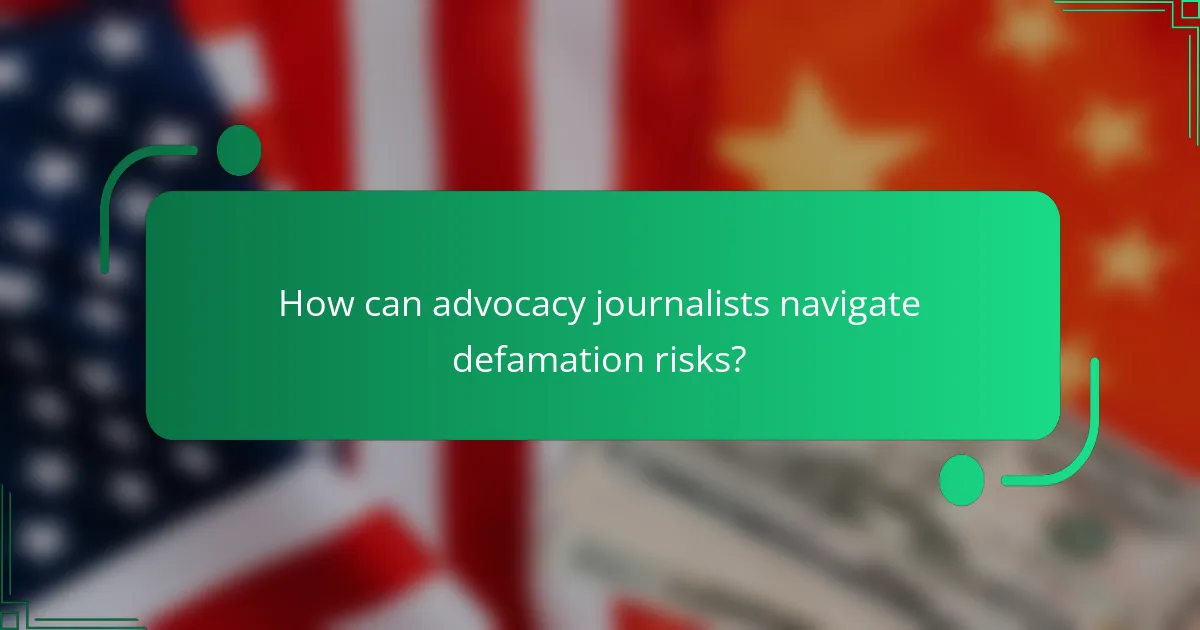
How can advocacy journalists navigate defamation risks?
Advocacy journalists can navigate defamation risks by understanding legal standards, employing careful fact-checking, and maintaining transparency in their reporting. By being aware of the laws surrounding defamation, they can better protect themselves from potential legal challenges while still fulfilling their mission of advocacy.
Training on legal standards
Training on legal standards is essential for advocacy journalists to understand the nuances of defamation laws. This training should cover the definitions of defamation, the difference between libel and slander, and the requirements for proving a defamation claim, such as falsity and actual malice.
Workshops and online courses can provide practical insights into local laws, which may vary significantly. For instance, in the United States, the First Amendment offers broad protections for journalists, while other countries may have stricter regulations that require more caution.
Additionally, journalists should stay updated on relevant case law and legal precedents that could impact their work. Regularly consulting with legal experts can help ensure that their reporting aligns with current legal standards and reduces the risk of defamation claims.
